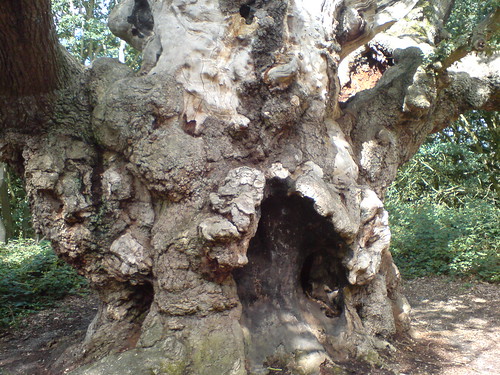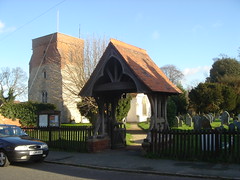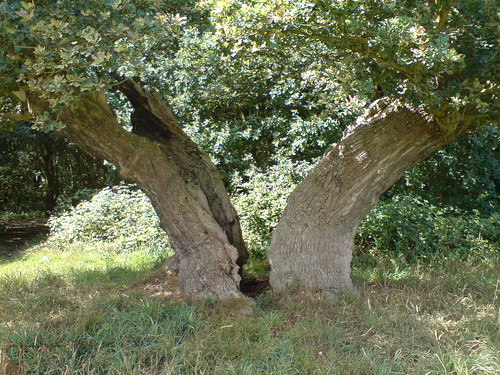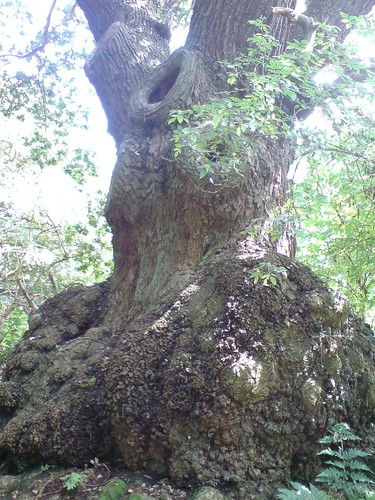
Woodland strolls are very much in keeping with my tree identification theme for this year. Currently on my reading list is Richard Mabey, Beechcombings which demonstrates with enough knowledge there is a great deal to be discovered in a wood.
I am not going to assimilate a lifetime of learning in a few hundred pages but at least it will improve on my lifetime of ignorance.
There are an alarming number of tree species in Britain, well over 2000. Most are exotic imports, there are 35 native trees and if I can identify those reliably along with a few imports it will be a pretty good start.
For the last few years I have been vaguely following the Ancient Tree Survey work that has been going on in the UK. Thinking about all those great trees of national interest or local importance I could visit. Then going through the backlog of my local MPs blog, Douglas Carswell, he mentions the plight of Old Knobbley (image).
Old Knobbley is the oldest tree in the area, maybe 800 years old, but certainly old. Turns out the chap needs some help as it is being out competed by trees around it and in some distress, possibly dying. The council got to work to prolong the life of the tree by cutting back some of the trees around it.
Well clearly a visit to the oldest tree in the area before it died is a darn good idea. A look at the Ancient Tree website showed this was not the only noteworthy tree in this small wood. Actually the place was littered with them. I'd guess the highest density of them in the area. Cannot be sure though, its a 3 year project in its early stages and rather reliant on public participation I imagine.
I have walked through the wood previously as an early part of the Essex Way and saw some old trees in passing. This always reminds me to measure a churchyard tree that is not on the Ancient Tree register which as I remember it must be a fair contender.
The 1891 OS map shows an oak grove which was still there in the 1940s maps but no longer exists. The area to the south, The Beech Plantation is still there though.
I put the tree co-ordinates and details into my gps. It would be a shame not to visit each one recorded, although this rather smacks of munro bagging to the exclusion of all other hills. Checklists are of dubious value once walking but purpose is useful, the balance is the trick.
The walk-in begins at Bradfield church, a building with a much repaired tower. The views across the fields to the Stour are inspiring on yet another baking hot day.

Image by drgillybean via Flickr
The walk goes past church remains. It is reputed the churchyard holds the remains of Matthew Hopkins, self-proclaimed witch-finder. A serial-killer and sadist essentially. It seems fitting any church would fall to the ground whose churchyard contained this poisonous character.
The track takes me past a stile that has no purpose, the fence it took you over no longer exits. Maybe it was a fence, but you can bet it was an ancient field boundary of hedgerow once. It does not sweeten my mood.
A torn leaflet is lying on the ground, I make out the fragments. Furze Hill is being thinned out, dogs to be on leads, dangers, stick to footpaths. The saving grace it starts tomorrow, it could go on for a month.
That is a stroke of luck. The wood is carefully managed and there is no need for significant alarm that the wood is being thinned. I am just glad I can wander without restriction or noise today.
It was thinned last time by nature and the 1987 Great Storm. The wood was planted in 1948, most likely to provide better cover for the secret govt bunker and buildings built around that time. The wood is much older than this. How old and why it exists is not totally clear. The great old trees could be what is left of a country estate.
The wood is generous, the old trees are just waiting to be touched and climbed if you wish. One oak has been cleaved in two at some date long forgotten. Almost a comedy cleaving, both halves of the tree lean away like a banana skin peel. Hollowed with age both trunks have a healthy canopy. I walk between the two halves just because I can.
There are many twisted and contorted trees, hollowed from fallen limbs, the remaining tree seemingly effortlessly defying gravity. One oak has massive growths on the base of its trunk. These burrs seem to be like a massive pair of hips.
Old Knobbley is the focus of the walk though, the oldest known tree in Tendring hundred. 600, maybe 800 years old. The area around him recently cleared to help this old timer find resources. He is splendid. I knew what to expect, in the modern age endless images and facts can be gleaned but until I stood in front of the tree I had no real sense of it.
I am not a tactile person but I had to touch the bark of that tree, to share part of the history. It was a tree of age when Matthew Hopkins was killing witches just down the road. The War of the Roses was going on when this tree had reached a maturity.
It is a timescale just on the bounds of my imagination for a living object. There are older trees in Britain but the age of these is beyond easy imagination.
The wood has a large pond at one edge, it was vibrant with birdlife when I strolled along one of its banks. Much youthful cheeping was going on among the water lillies. Trees of all ages, variety and slant were all around me. The woodland floor was sparse of plant life though. I look forward to seeing what the thinning process throws up in future years.
It is not a big wood, but there are so many interesting trees and the walking over the undulations of countryside is great fun. With a little extra knowledge, the helpful guide of the ancient tree study and its resultant shift in my focus, my entire outlook on this wood had changed.
Previously whenever I was here, it was something walked through on a point A to B exercise. This time the wood was the walk and it was great to give it the time for it to tell me a bit about itself.




Great blog post. You might be interested to hear that some of the younger trees blocking out the light from my branches have been removed and are helping to make a replica of the Mayflower. More photos and info about Old Knobbley at www.oldknobbley.com. Glad you enjoyed the walk around the wood - great trees eh? Old K
ReplyDeleteHow remiss of me. http://www.oldknobbley.com/
ReplyDeleteThis venerable tree has his very own web presence and is more than capable of surfing the internet.